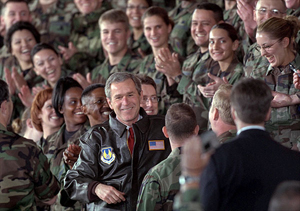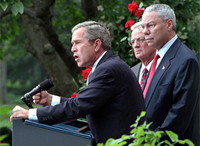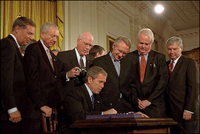|


| | President George W. Bush is greeted with a thunderous cheer as he talks with troops during his visit to Eglin Air Force Base in Florida February 4. White House photo by Paul Morse.
| |
| October 7 marks the one-year anniversary of the beginning of combat operations in Afghanistan. Many of the coalition's objectives in Afghanistan have been accomplished
- With the coalition's help, Afghanistan is moving forward to rebuild their country and restore civil government.
- One month after military operations began, the first major city -- Mazar-e-Sharif
-- was liberated. A month later, the last major city -- Kandahar -- was liberated from the Taliban.
- The al Qaeda went on the run days after Oct. 7 -- losing their power, their safe havens and much of their leadership. Today, they are fragmented and their leaders are missing, captured, killed or on the run.
- Humanitarian aid to Afghanistan started on day one of the war, with 37,000 humanitarian daily rations airdropped while the attacks were underway.
- The international community has pledged $4.5 billion over five years to reconstruct Afghanistan; $2 billion was committed for use in 2002. Of that $2 billion, $1.3 billion has been utilized or will be available this year.
- More than 575,000 metric tons of food have been delivered since the start of the war; 1.7 million refugees have returned to their homes. Schools, hospitals and roads have been rebuilt.
- An elected head of government - Hamid Karzai - today works with regional leaders in a transitional government as civil authorities continue to establish control.
The coalition continues to pursue terrorists, whether by financial, diplomatic, legal or military means.
- More than 160 countries have issued orders freezing terrorist assets, and others have requested U.S. help in improving their legal and regulatory systems so they can more effectively block terrorist funds. Since September 11, the U.S. has blocked more than $34 million in assets of terrorist organizations; other nations have also blocked more than $77 million.
 Terrorists and terrorist cells continue to be disrupted or destroyed on a daily basis. With the global efforts of law enforcement and intelligence agencies in cooperation with some 90 countries, resulting in the arrest of some 2,400 individuals, and approximately 650 enemy combatants under U.S. control. Terrorists and terrorist cells continue to be disrupted or destroyed on a daily basis. With the global efforts of law enforcement and intelligence agencies in cooperation with some 90 countries, resulting in the arrest of some 2,400 individuals, and approximately 650 enemy combatants under U.S. control.
- The North American Aerospace Defense Command (NORAD) has conducted more than 25,000 Operation Noble Eagle sorties, including, 17,600 combat air patrols. At the same time, U.S. fighters have been scrambled or diverted to respond to over 750 domestic airspace security incidents.
- On Sept. 12, 2001, the North American Treaty Organization invoked article V for the first time. Coming to the aid of the U.S., NATO planes flew more than 350 sorties and logged more that 4,300 flight hours as part of operation Noble Eagle.
Global War on Terror:
Facts & Figures
Reconstruction & Humanitarian Aid
- The United States has provided some $588 million in assistance since October 2001. Another $1.45 billion has been authorized for this purpose over the next four years.
- The U.S. has provided 7,000 metric tons of seed and 15,000 metric tons of fertilizer, benefiting more than 140,000 Afghan farmers.
- On September 12, 2002, Japan and Saudi Arabia joined the U.S. in announcing support for the rebuilding of the Kabul-Kandahar-Herat highway. The U.S. pledged $80 million and our partners $50 million each.
- Ten water projects were completed during the first six months of 2002. These included 83 wells, benefiting approximately 260,000 Afghans, at a cost of $193,000. Focus for this effort was Kandahar and Mazar-e-Sharif. An additional 16 new water projects have been approved in the provinces of Paktika, Khowst, Kandahar, and Kabul, with an estimated total cost of $246,000.
- De-mining teams from Norway, Britain, Poland and Jordan have helped clear land mines from more than 1.8 million square meters of terrain.
 |
Infrastructure projects |
 |
 |

Infrastructure projects: 154 approved projects in 10 provinces:
|
Completed |
Underway |
| Agriculture |
2 |
2 |
| Roads and Bridge |
1 |
7 |
| Hospital / Medical |
5 |
14 |
| Schools |
61 |
44 |
| Water and Wells |
10 |
16 |
| Other Projects |
4 |
9 |
 |
 |
 |
Schools
- U.S. Army Civil Affairs has completed 61 school repair projects -- with plans for 44 more -- to support more than 70,000 school children.
- The U.S. has provided 10 million textbooks and 4,000 teacher-training kits.
- Canada, Greece, Belgium and Iceland delivered 60 metric tons of goods donated by Egypt to Afghanistan.
Medical
- Jordan built a hospital in Mazar-e-Sharif that has treated more than 105,000 patients.
- Spain’s hospital has treated nearly 12,000 Afghans and provided 26 tons of pharmaceutical supplies.
- Belgium led the largest multinational humanitarian assistance mission that delivered 90 metric tons of UNIMIX to starving children in Afghanistan. It also provided 2,500 blankets.
- The U.S. has jointly funded the measles vaccinations of more than four million children.
Coalition Support
Operation Enduring Freedom
Twenty-seven nations have deployed more than 14,000 troops in support of OEF. Coalition support has been invaluable. For a partial listing of some of the countries and some of the support provided, see www.centcom.mil.
 Singapore recently broke up a terrorist cell linked to al-Qaeda that was planning attacks against American targets. Thirteen suspects are now in custody. Singapore recently broke up a terrorist cell linked to al-Qaeda that was planning attacks against American targets. Thirteen suspects are now in custody.
Spain has taken several terrorist suspects into custody, including a suspected senior al-Qaeda financier and another suspect who had videotaped several American landmarks like the Golden Gate Bridge, the Statue of Liberty and the Sears Tower.
Morocco has arrested several al-Qaeda suspects who we believe were planning attacks on American and British targets.
Germany has been an indispensable law enforcement partner as well -- including arresting several terrorist suspects.
International Security Assistance Force (ISAF)
Troops from 19 countries make up the International Security Assistance Force, a force organized to assist the transitional Afghan government with security in the capital, Kabul. During its first six months of operation, ISAF mounted 2,185 joint patrols with Afghan security forces in and around Kabul, and disposed of nearly 3 million munitions.
Other Operations
In The Philippines
More than 1,300 US personnel, including 160 Special Operations advisors, deployed in support of the Balikatan counterterrorism exercises for 6 months. U.S. Special Operations personnel conducted company-level training with 25 field companies of the Armed Forces of the Philippines. The U.S. has provided the Armed Forces of the Philippines with one C-130 aircraft, 30,000 M-16A1 rifles, two Point-class Coast Guard cutters, and eight UH-1H helicopters.
 In the Republic of Georgia In the Republic of Georgia
U.S. Special Forces trained nearly 200 Georgians during the staff-training phase of the Georgia Train and Equip Program. Currently, they are training nearly 500 Georgians in light-infantry tactics, including platoon-level offensive and defensive operations and basic airmobile tactics. Military equipment is also slated for transfer to Georgia, including uniforms, small arms and ammunition, communications gear, training gear, medical gear, fuel, and construction materials.
In Yemen
U.S. Special Forces trained approximately 200 Yemeni military forces in counter-terrorism tactics.
|





 Terrorists and terrorist cells continue to be disrupted or destroyed on a daily basis. With the global efforts of law enforcement and intelligence agencies in cooperation with some 90 countries, resulting in the arrest of some 2,400 individuals, and approximately 650 enemy combatants under U.S. control.
Terrorists and terrorist cells continue to be disrupted or destroyed on a daily basis. With the global efforts of law enforcement and intelligence agencies in cooperation with some 90 countries, resulting in the arrest of some 2,400 individuals, and approximately 650 enemy combatants under U.S. control.
 Singapore recently broke up a terrorist cell linked to al-Qaeda that was planning attacks against American targets. Thirteen suspects are now in custody.
Singapore recently broke up a terrorist cell linked to al-Qaeda that was planning attacks against American targets. Thirteen suspects are now in custody.
 In the Republic of Georgia
In the Republic of Georgia
